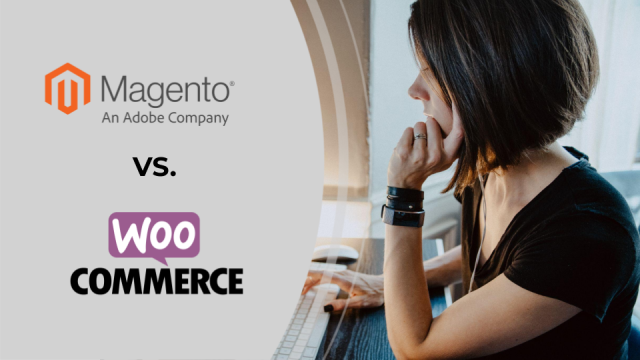Magento vs WooCommerce. Many merchants are asking themselves which option to choose as they seek out the best ecommerce platform.
Here’s a side-by-side comparison of Magento vs WooCommerce to help you make up your mind.
What are Magento and WooCommerce?
Magento and WooCommerce are two of the biggest names when it comes to ecommerce platforms. They are both open-source platforms that require some technical knowledge, whether that’s from you, your in-house team or outsourced developers. However, Magento requires coding and isn’t recommended for businesses without dedicated development resources.
WooCommerce is a WordPress Plugin that can be implemented without a developer by anyone who is comfortable working in WordPress or who is willing to take some time to learn and do some online research.
Comparing Costs: Magento Open Source vs WooCommerce
Magento Open Source Costs
Magento Open Source is a free platform, but it has associated costs. If you haven’t already, you will have to pay for:
- Website hosting service starting from $10
- Good website theme (as much as $200 or more)
- Domain name from $10 to $500+
- Plus the cost of development to implement the system properly, which can easily reach into the tens-of-thousands or more
WooCommerce Costs
Similarly, WooCommerce is free — but you’ll need to pay for the same associated costs mentioned a moment ago. But do bear in mind that you may need to pay for more plugins with WooCommerce than you have to with Magento Open Source because Magento includes more robust functionality.
Magento vs WooCommerce – Which is Better?
It depends on your needs. Both Magento Open Source and WooCommerce have impressive functionality and flexibility while being free to download and install.
- Magento has greater out-of-the-box functionality, customizability and a broad selection of powerful third-party plugins to add virtually any functionality you could ever need.
- Magento Commerce, the company’s paid offering, is feature-rich and includes support. The minimum price is $22,000 per year. And if you have revenue of more than $1 million per year, it will cost more
- WooCommerce developers have made the platform available to anyone as a plugin that is added to WordPress websites. If you don’t use WordPress, then WooCommerce isn’t the right solution
- Businesses looking for an easy no-coding-required and low-cost solution that doesn’t require WordPress should consider Shopify or Wix
WooCommerce vs Magento Features Comparison
| Subscriptions | Testimonials | Reward Points | WYSIWYG Editor | Form CAPTCHA | |
| Magento | Y | Y | Yes (Enterprise Edition) | Y | Y |
| WooCommerce | Y | Y | Y | Y | Add On |

User Experience: Magento vs WooCommerce Comparison
Both platforms offer merchants a great user experience — but there are some key differences that may sway you towards one platform or the other.
Using Magento as a Merchant
Magento Open Source will suit web development professionals and medium-to-large online stores. Coding knowledge is needed to get the most of Magento. That means you will need a professional developer. The Magento setup is targeted at developers, rather than non-technical retail and ecommerce professionals.
Using WooCommerce as a Merchant
Think of WooCommerce as the SME option. It comes with a setup wizard that walks you through your initial setup, where you can select store details and industries. You can personalize your website, install plugins and add functionality and features like subscriptions, visual search and international payments.
Customer Support for Merchants
If you want on-demand support, then neither WooCommerce nor Magento Open Source is a good fit for you. That said, both WooCommerce and Magento Open Source have large user communities. And the members of those communities support each other and are quick to address questions and issues.
If you opt for the paid Magento Commerce solution, then you get email and live support included in the $22,000 annual price tag.
Cross-Border and International Sales
Whether you choose Magento or WooCommerce, you’ll need a payments plugin that localizes your customers’ checkout experience with the payment options they prefer if you plan to transact internationally, or if you are doing business in countries where credit cards and PayPal aren’t the only popular payment methods.
Providing relevant local payment options based on a customer’s location will help you reach customers and grow sales anywhere. Rapyd provides an easy-to-integrate payment plugin for both platforms to help merchants grow their sales with cross-border customers.
Which eCommerce Platform is Right For You?
WooCommerce offers user-friendliness, low costs and flexibility. Magento offers robust functionality and customizability for technical users. For early-stage online businesses, WooCommerce could be the way to go. Magento Open Source offers a gateway to enterprise-grade performance.
Grow Globally With Rapyd’s
Ecommerce Payment Plugins
Rapyd’s Ecommerce plugins let you accept hundreds of payment methods, including local and alternative payment methods from all over the globe, giving more customers access to your business.
Serving over 50 countries and with local settlement in whatever currency you choose, it’s one of the most comprehensive options available whether you want to accept international payments in your ecommerce store with Rapyd’s global payment plugins for Magento and WooCommerce.
Subscribe Via Email
Thank You!
You’ve Been Subscribed.



